The Golden Anniversary: The Church History, Second Presbyterian Church, 1903–1953 program tells:
Back over the brow of Penn Avenue hill, a short distance from the William Penn Highway, stands a little brick church. Out from little Beulah came a group of people who started a Sunday school in the village of Wilkinsburg. There was discovered recently a letter dated December 10, 1869, addressed to the Reverend S. M. Henderson, then the pastor of the Presbyterian Church of Wilkinsburg, and signed by J. Morgan Kuhn. in which Mr. Kuhn tells how in the summer of 1839, a number of children were gathered in a Sunday school, which was started in the old brick school house. He was the first superintendent, and he named a number of teachers. From this Sunday school came the Presbyterian Church of Wilkinsburg, organized in 1866. From the Wilkinsburg Presbyterian Church came the Waverly Presbyterian Church, the Blackadore Presyterian Church, the Edgewood Presbyterian Church, and the Ardmore Presbyterian Church. Little Beulah on the hill is the mother and grandmother of churches, and she now has quite a family.
In 1898 Wilkinsburg was a rapidly growing and thriving suburb of Pittsburgh. Many Presbyterians were moving into town. The First Church had grown so large that it was difficult for one minister to look after it. Assistant pastors in those days were rare. Many of these new people were drifting into other churches and denominations, which fact boded no good for the Presbyterian faith. Many were not attending anywhere. A sense of responsibility grew up in the hearts of many of the people of the First Church for these families that needed shepherding. Presbytery began to see the need of a second church in Wilkinsburg, In the latter part of 1898, a definite movement looking to the organization of a second church developed. As usual a difference of opinion at once arose. Some of the members opposed it. They argued that it was a bad time to start another church.
The church building, which then stood at the corner of Wood Street and South Avenue was growing old and dilapidated and a new building was needed. The congregation had purchased a lot at the corner of Wood Street and Wallace Avenue where the present First Church now stands.
The congregation agreed to sell the lot at Wood Street and South Avenue. Proceeds went into a trust fund with part of the trust fund allocated for the Second Church. The congregation built the First Church at Wood Street and Wallace Avenue.
Several years went by, during which the Second Church group gave hearty support to the First Church.
. . . .
Early in August of 1903, Edward T. Jackson, W. Frank Bremner, and Harry E. Carmack met and discussed the matter of a second church. Mr. Jackson’s grandfather, Edward Thompson, was one of the charter members of the First Church. His father and mother were members, and he had grown up in the church. Mr. Bremner was a member of the Session, a teacher in the Sunday School, and an active worker in the church. Mr. Carmack had joined the church, when a boy, had been a pupil in the Sunday school, a teacher, and assistant superintendent of the Sunday school. Many of the other charter members of the Second Church were active members in the First Church. There was no dissension or dissatisfaction. Those interested in the new church were actuated by a strong sense of duty, by a clear vision of the need of another church. . . .
A meeting was called for August 17, 1903, at eight o’clock in the large room on the third floor of the First National Bank Building. Seventeen men attended this meeting and exchanged views on the matter of a new church. All were in favor of the movement. The meeting adjourned to meet a week later in the same place. This meeting was attended by forty men. They were so enthusiastic and unanimous that $1,400.00 was subscribed for the current expenses of the new church. It was decided to call a public meeting two weeks later of all parties interested. This meeting convened at Penn Hall, on the third floor of the building adjoining the Caldwell and Graham building on Penn Avenue. There was great enthusiasm at this meeting, and it was decided to prepare a petition to Presbytery asking for permission to organize a new church to be known as the Second Presbyterian Church of Wilkinsburg.
. . . .
While the committee from Presbytery were conferring with the Committee from the churches, it was decided to proceed with the organization of thc Sunday School. Accordingly the Sunday School met for organization in Penn Hall on Sunday, October 25, 1903, There were 146 present, men, women, and children. A temporary organization was effected. Mr. Harry E. Carmack acted as Superintendent, Mr. W. Frank Bremner and Mr. Edward T. Jackson as Assistant Superintendents, Miss Anna Campbell (Mrs. William M. Findley) took charge of the Primary Department. Twenty-three teachers took charge of the classes.
October 27, 1903 was the eventful day in the history of this church. On that evening the excited and happy signers of the petition to Presbytery met in Penn Hall, together with a number of persons anxious to join the new church. The Committee from Presbytery organized the church in accordance with the requirements of the Presbyterian Church in the United States of America. The sermon was preached by the Reverend C. W. Wycoff, D.O. Two hundred persons were received by letter from the First Church, nineteen from other churches and nine upon confession of faith, making a total of 228.
. . . .
Thus, in a remarkably short time the new church was thoroughly organized and ready for work, with all the subsidiary organizations usual in an up-to-date church in good running order.
This opening period of our church history is certainly one never to be forgotten by those privileged to share in it. The large and active membership showed that there was a real necessity for a second church. The separation from the First Church had been accomplished without bitter feeling. Faith was strong, hope for the future was bright, everybody was cheerful and happy. There was work for all, and all entered into their new tasks with zeal and enthusiasm. Everyone looked forward to a great work to be done for Christ and the Kingdom.
Two matters of great importance now faced the congregation, first, the securing of a pastor, and second, the securing of a church home. Doctor Breed was asked to serve as a supply, and until a pastor was finally called, Doctor Breed and Doctor Samuel B. McCormick frequently filled the pulpit and were of great assistance to the young congregation. It must also be recorded that Doctor Sherrard, a retired Presbyterian minister, gave great assistance as Moderator of the Session. He was a Godly and saintly man. It was a benediction to look into his face and to listen to his voice. He conducted our prayer meetings and a number of our communion services. Always he was a kind, gentle friend, ever ready to give counsel to individuals or to the church; ever ready to help and guide us with the aid of a long and wonderfully rich Christian experience. It is many years since he went home to his well-earned reward, but he will always have a place in the affectionate memories of those who were charter members of this church, as well as in the life of the church itself.
While endeavoring to secure a pastor, but without waiting until that most important matter was accomplished, the congregation went ahead with its other plans. The congregation was incorporated under the laws of the State of Pennsylvania in December, 1904. . . .
The next great question was where the church should be located.
The congregation considered a lot at the corner of South Avenue and Mulberry Street.
It was proposed to purchase two lots at this location, one at the corner, fronting 50 feet on South by 132 feet along Mulberry, and the other adjoining, fronting 66 feet on South and extending back 132 feet, making a total of 116 by 132 feet. There were three houses erected on these lots, two on South and one on Mulberry. This made the price of the lots very high. and there was some hesitation about buying them. However, it was evident that this was one of the best locations in the entire borough of Wilkinsburg, and it was decided to purchase them.
. . . .
After a long and trying experience in endeavoring to secure a pastor for the church, a call was finally issued on April 20. 1904, to Reverend John A, Marquis, D.O., of Redlands, California. Doctor Marquis was reluctant to accept the call, owing to the fact that he had been at Redlands only a very short time. However. he came to Wilkinsburg and preached for the congregation during the month of July. He subsequently declined the call.
. . . .
At a congregational meeting held October 26, 1904, a building committee was chosen consisting of H. L. Herr, Edward T. Jackson, and Ira C. Ewing. Under the direction and supervision of this committee the work of building the chapel at once proceeded and was prosecuted rapidly to completion. During the erection of the chapel, after the foundation had been laid, the first floor joists laid, and the walls partially erected. the Sunday School had a lesson on the “Rebuilding of the Temple.” The entire school marched from Penn Hall down to the church lot. The first floor joists were covered with boards temporarily and here a brief service was held. This was March 26, 1905.

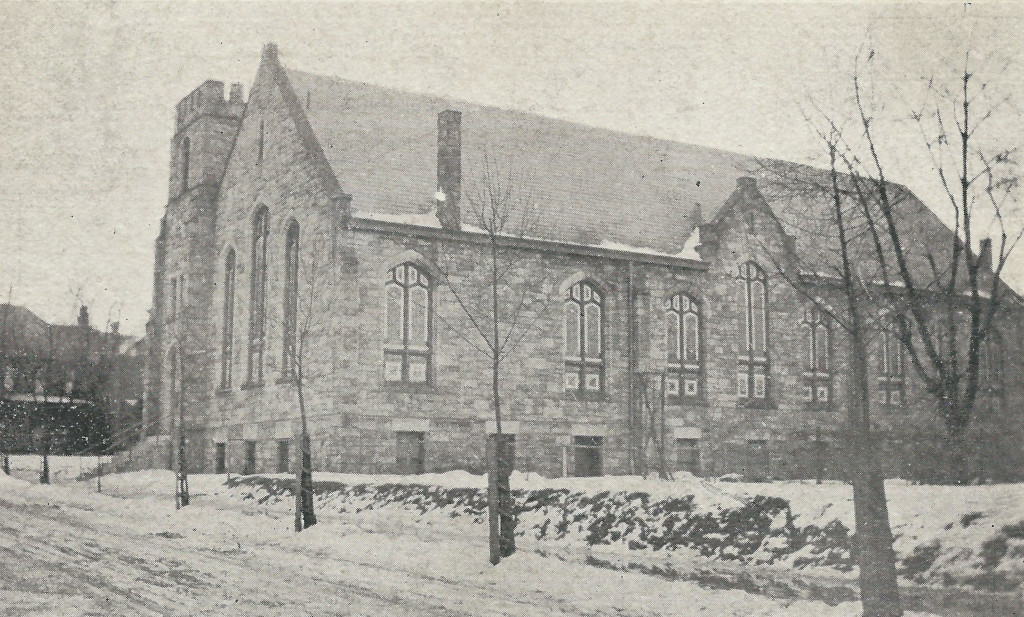
Dr. Breed and Dr. McCormick continued to supply the pulpit from time to time until finally in December, 1905, a unanimous call was extended to Dr. George Whitfield Mead of Newport, Rhode Island. He accepted the call and was installed February 4.
From the foregoing record it appears that this church had a rapid growth, having added over 100 to its membership, that it purchased a lot and erected a chapel, that in every department and organization there was great activity and a warm, glowing, spiritual life–all without a minister, surely a remarkable achievement.
Nevertheless the congregation had greatly missed the ministration of a faithful pastor, and there was great rejoicing at the coming of the first pastor, Dr. Mead. He took hold of the work with promptness and vigor. He soon won his way into our hearts by his modest, kind, and gentle manner, by his thoughtful and helpful sermons, by his reverend, earnest and spiritual prayers. Under the leadership of George Sulzner, a chorus choir was organized, which sat in the east gallery, which was not then enclosed. The friendliness and sociability of the young church was a theme of common remark. As there were no pews, the people sat on chairs, and it was easy after the service to walk straight across the room shoving the chairs aside. This made social contacts easy and more numerous. In our present large auditorium with immovable pews, it is not so easy to be sociable.
Rev. Mead wrote “Social and Spiritual” in a section of The Expositor and Current Anecdotes that explored ways of encouraging church attendance.
When the names of any new comers to our church or city, or the names of any unchurched people in our community, can be obtained, they are entered in the Pastor’s “Strangers’-Book,” which is our garden to till, requiring most earnest care and prayer. Out of the names of three hundred strangers so obtained, seventy-eight have become communicant members of our church in the last seven months. . . .
Our people are watchful to welcome strangers at the church service. . . .
True Christian hospitality prevails. Our Christian endeavorers call on young people. Our young people visit young men and invite them to the Bible-class, Men’s Club, etc. Families of the church have a habit of having different young men in their homes every week to dinner. The ladies of the church have an “at home” day once a month in the church parlors, a purely social hour with music, etc., and light refreshments, to which all ladies whose names are on the “strangers’ book“ receive a written invitation. The ladies call upon the strangers, as do many of our men, especially of the Men’s Association and the Board of Deacons. The pastor’s home is open informally every Thursday afternoon and evening to the congregation. The week following each Communion service, all who united with the church at that time are invited to the pastor’s home for an evening, when one of the church boards and their wives assist in entertaining. These various social hours are social, as sunshiny and cheery as possible, but never do we lose sight our supreme aim: to bring people to God and help them to a consecrated service.
Another important factor is our Pastor’s Aid Society. The city is divided into 21 circles, with a leader or leaders (usually a man and his wife) over each circle. Members of the congregation belong to the circle in which they live. Each circle has individual meetings, and the leaders of the circle report to the pastor once a month.
Rev. Mead resigned in March 10, 1910 due to health issues, after a leave of absence, time in a sanitarium, and a slow recovery.
The Golden Anniversary Program tells:
The congregation then extended a call to the Reverend J. Allison Platts of Bellefonte. Pa., on November 16, 1910. Dr. Platts accepted the call and came to the church early in December. The church immediately felt the impetus of his strong and vigorous personality and his splendid capacity for leadership. The prayer meetings and the church services were well attended, and the membership continued to increase rapidly. It became more and more evident that a larger auditorium would have to be provided to accommodate the ever increasing numbers. The beautiful auditorium in which we now meet is the outstanding achievement of this congregation under the masterly leadership of Dr. Platts.
In seven months after Dr. Platts took charge, the congregation met on July 11, 1911, to ratify a contract for the erection of the new church auditorium. The contract was awarded to F. Hoffman and Company for $35,775. The total cost of the new building and its equipment, including the organ was about $56,000. The corner stone was laid on August 16, 1911. Addresses were made by the Rev. Dr. Nevin and Dr. Stewart. Dr. Platts led in prayer, two hymns were sung, and representatives from each of the organizations in the church deposited records in the box, which was sealed in the corner stone. The building committee consisted of A. K. King, George V. Craighead, A. C. Bartlett, John Grabe, L. A. Brown, C. M. Johnston, A. O. Pyle and R. L. Finley. The auditorium was dedicated to the worship of God, April 7, 1912.

Rev. Platts died of pneumonia on June 23, 1912.
Rev. Charles G. Jordan started in January 1913 but resigned in September to return to evangelistic work.
In January 1914, Rev. Samuel Willis McKelvey, of the Avalon Presbyterian Church became the minister. The congregation offered support to Billy Sunday evangelistic campaigns. On March 29, 1914, 189 new members joined the church.

The Biederwolf Campaign in early 1917 lead to a tabernacle being constructed on Wallace Avenue with all the Wilkinsburg churches uniting for services extending over a number of weeks.
In 1918 many of the boys of our church were called into the Army and Navy and left us for the various camps and training stations. Those were anxious days for us all. Our women were active in Red Cross work. All minds and hearts were turned toward the scene of the great conflict; and there was a great rejoicing when the Armistice was signed, and the boys came back to us again. On October 15, 1919, a bronze tablet was erected in the vestibule of the church in honor of the young men of the Second Presbyterian Church who had served in the Army and Navy during the war.
Rev. McKelvey resigned on February 21, 1921 to accept a call at the St. Paul’s Presbyterian Church of Philadelphia. “As a pastor Dr. McKelvey had been fearless, outspoken, and earnest. He preached the whole gospel, and God blessed his testimony in the salvation of many souls and in the edification of our people.”
Rev. Hugh Leith began on October 20, 1921.
Modest, earnest, conscientious and hard-working, he led us into new and greater fields of endeavor. There was no let up in the continuous growth and progress of the church. He too won our love by his fine example, his social qualities, his faithful ministrations to the sick and those in sorrow, and his thoughtful inspiring sermons.”
With the work and direction of Rose Russell, the Children’s Division grew until the enlarged facilities became needed. “It was through Miss Russell’s vision and courageous convictions that our people were brought to a decision to erect the new educational building.”
The congregation in 1922 authorized the purchase of the land for the future educational building. The planned expansion included $10,000 to rebuild the organ and $65,000 for the building the addition.
Miss Rose Russell provided the funds for our children’s chapel in memory of her parents, Mr. and Mrs. J. K. Russell, both of whom had been active in the church . . .The building project was approved on April 18, 1928. and the following building committee was selected: Mr. J. E. McCollough, Chairman; C. A. Tyler, F. E. Cronkhite, John C. Grabe. H. S. Loomis, Miss Rose Russell, and Mrs. H. C. Nagel. The contract for the building was awarded to Stewart M. Wilson, August 22, 1928, for $105,288. Mr. Lawrence Wolf[e] was the architect.
Rev. Leith resigned in August 1929 to serve in Mt. Lebanon.
The fine new building for housing the church school (as it was now called) was built according to the most up-to-date plans for church school architecture. The cornerstone was laid by the Children’s Division, November 25, 1928, and the dedication occurred September 15, 1929.
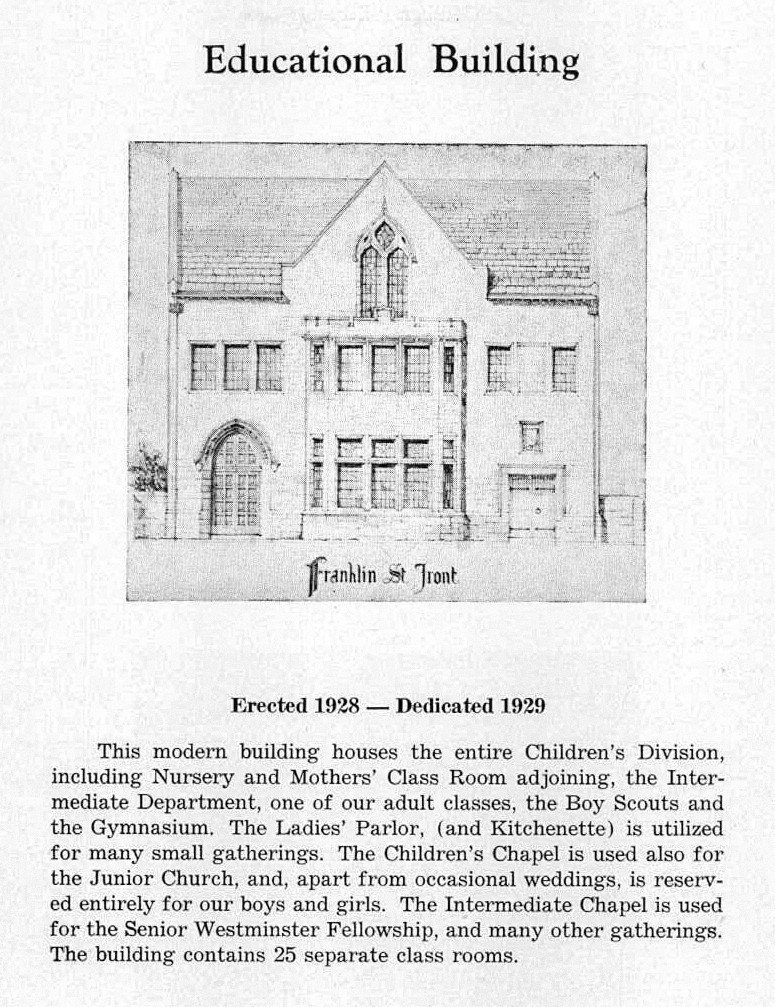
Golden Anniversary: The Church History, 1953
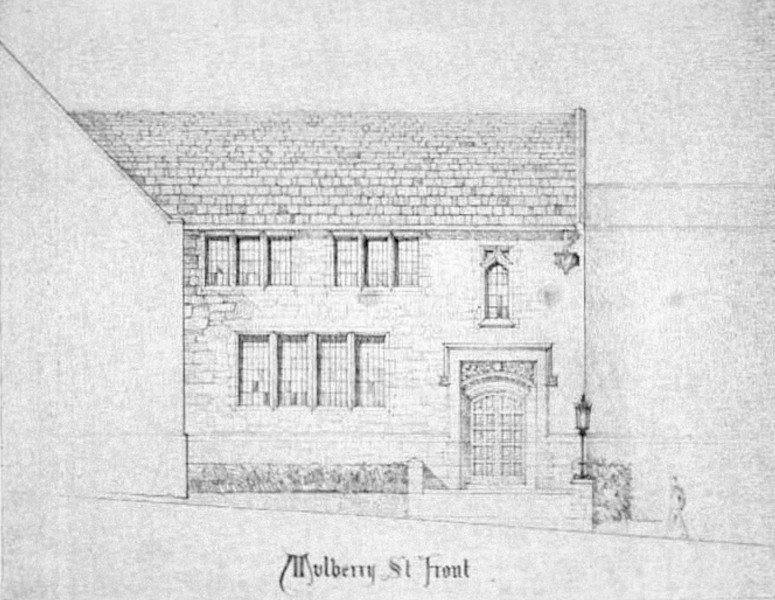
Golden Anniversary: The Church History, 1953
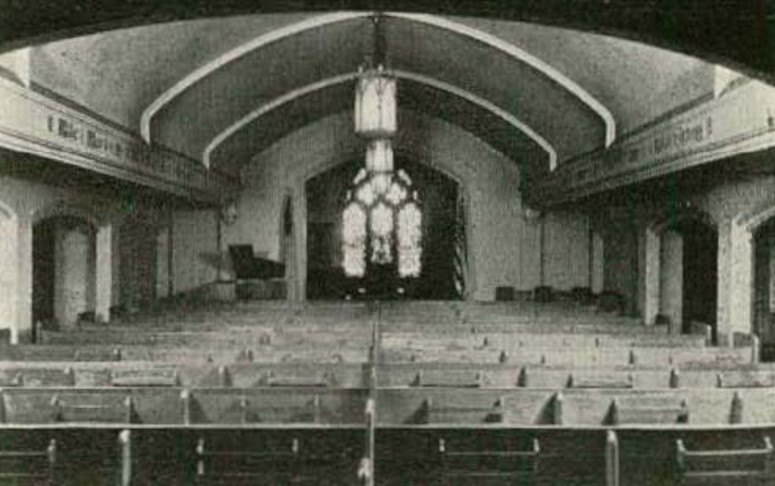
Golden Anniversary: The Church History, 1953
The congregation called Rev. John Franklin Troupe, D.D. from the Giddings Presbyterian Church, Missouri on March 12, 1930.
A Pennsylvanian by birth Dr. Troupe with his family soon made himself at home among us and began a pastorate of tremendous energy and activity. One hundred and five new members joined the church a few months after his coming. Dr. Troupe made 2300 pastoral calls in the first eighteen months of his service with us.
The desire to utilize our gymnasium to the fullest, led in 1938 to the formation of a church-wide committee, of which Mr. I. B. Steifel was the chairman, to sponsor the athletic program of our church organization. Since that time the gymnasium has been a very definite factor in church life, especially among the young people. Our associate pastors have usually given the spark of life to a varying program. Our basketball teams down through the years have won more trophies than have any other church teams in the borough, and our softball teams have frequently won championships. Younger groups, including the Boy Scouts, have had their share in the enjoyment of the gymnasium.
. . . .
One of the contributing factors in the expansion of our church in membership and program has been the establishment of group committees. These committees, set up under the leadership of incumbant or former elders, are usually made up of people who live in the same locality and are familiar with church members in that locality. They have done much to assist in pastoral and sessional oversight of the church, making visitations and reporting illnesses and persons needing pastoral calls. First there were seven such committee groups; later the number was increased to ten; and now the number is fifty-one. More than 150 persons can be recruited for visitations upon the entire membership.
. . . .
The beginning of the church year of 1935 found the church near its highest peak of efficiency and organization. It was a shock therefore when circumstances developed that caused the joint boards to accept Dr. Troupe’s resignation. A committee was immediately formed and a calm search for a new pastor was begun.
During the months the church was without a pastor, Dr. Thomas Watters, appointed by Presbytery as Moderator of Session, served in a large degree as a pastor in shepherding our people and giving wise counsel and gracious leadership.
The search committee found Rev. James W. Laurie.
He was called July 1, 1936, from the Second Presbyterian Church of Rahway, New Jersey, and came to us September 20, 1936. He was installed on September 30th. in an impressive service at which his father, Rev. J. A. Laurie, D.D., gave the charge to his son. He and his charming wife found their places immediately in the hearts of our congregation. With great rapidity old wounds were healed and our church continued its forward march.
. . . .
In the year 1942 one of the greatest turning points in our Church’s history was experienced. The Central Presbyterian Church, Buffalo, New York, one of the great churches in the United States, glanced wishfully in the direction of our splendid Pastor. After much persuasion on the part of the Buffalo Church Committee, and prayer by Dr. and Mrs. Laurie, it was concluded that God had called our Pastor to a larger and more responsible field. On May 24, 1942, Dr. Laurie preached his farewell sermon, and early the next morning he and his beloved wife, with Jean, Sally and Mary, moved to their new home, and he was formally installed as Minister on June 9th.
Once again the Committee of our Church set about the Herculean task of selecting Dr. Laurie’s successor. The Committee, working with great difficulty in the time of war-restricted driving and travel, spent many weeks in visitations and interviews. Finally the Committee recommended that we call the Rev. Clem Bininger, who had been serving the Shaker Heights Presbyterian Church, near Cleveland, Ohio. Following the Committee’s suggestion, and approval by the congregation, Dr. Bininger was installed as our next Minister on January 13, 1943. The steady progress was scarcely interrupted and the future seemed bright. Dr. Bininger took over a united congregation, and his wife and three fine children became beloved members of a great church family.
. . . .
In October of 1946 we had the glad experience of burning the mortgage bond; and, for the first time, the church and church school were free from debt.
. . . .
On December 28, 1947 at a special congregational meeting Dr. Clem Bininger presented his resignation, he having been called to the Grace Covenant Church, Richmond, Virginia. He left us on January 15, 1948, and the future seemed dark. His influence upon our church and community was tremendous; his brilliance as a speaker and his earnestness as a leader were recognized by all.
The search for his successor continued until May, 1948, when a call was issued unanimously to Reverend Vernon P. Martin, Jr. of Cincinnati, Ohio, where he had served as pastor of the students of the University of Cincinnati. As he began his pastorate with us, June 27, 1948, a united congregation soon felt the warmth of a personality that had endeared Dr. Martin to a great student body.
The new organ chimes were dedicated May 28, 1950 to those eleven men of our church and church school who made the supreme sacrifice in World War II. Three hundred and thirty-five young men and women of our church family served in this war, establishing a proud record.
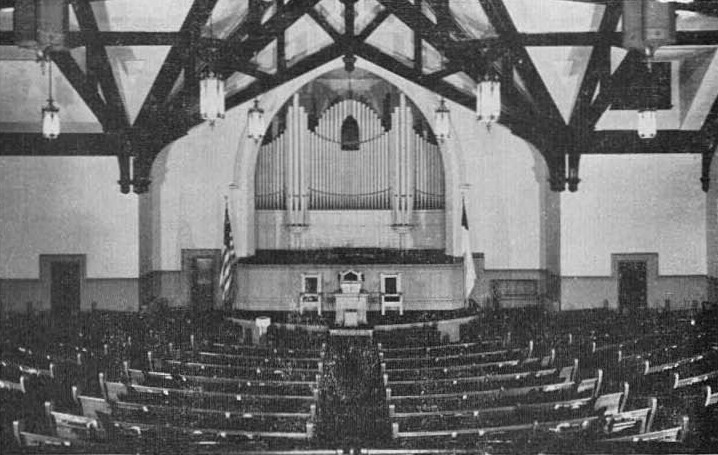
The 1950s “We Welcome You“ brochure describes:
Over 2,100 active members; 38th in size among 8,637 Presbyterian churches in the nation; third largest church in Pittsburgh Presbytery, the second largest Presbytery in the world.
. . . .
The Church Staff consists of a Minister, an Assistant Minister, a Director of Christian Education, a Director of Music, an Organist, two Secretaries, and two Custodians. The church is open every day—all day. For appointments, phone Penhurst 2484.
One page describes the church school and youth programs.
1. We have the largest Church School in Pittsburgh Presbytery, about 1,300 members, with interesting and instructive classes for all ages. Our educational building is one of the largest and most modern in the U.S.A.
2. A beautiful Children’s Chapel, which was specially constructed and fitted to their requirements, is located in our Educational Building. Junior Church is conducted by the Assistant Minister each Sunday morning at 11:00 A.M. from October through May.
3. Three Youth Groups: for Junior High students, Senior High students and Older Young People.
4. Organizations using facilities of the Church include: Boy Scouts, Tuesday, 7:00 to 9:00 P.M.; Girl Scouts, Tuesday, 4:00 to 5:30 P.M.; Sewing and Quilting Groups, Thursday, 10:00 A.M. to 3:00 P.M.; Junior and Senior Basketball, Friday, 8:00 to 10:00 P.M.
5. The Church has 59 rooms and 49 alcoves, closets and storage rooms.
6. A full equipped gymnasium with locker and shower rooms is available to use of Church and Church School members and their friends. Basketball and softball are played under competent leadership.
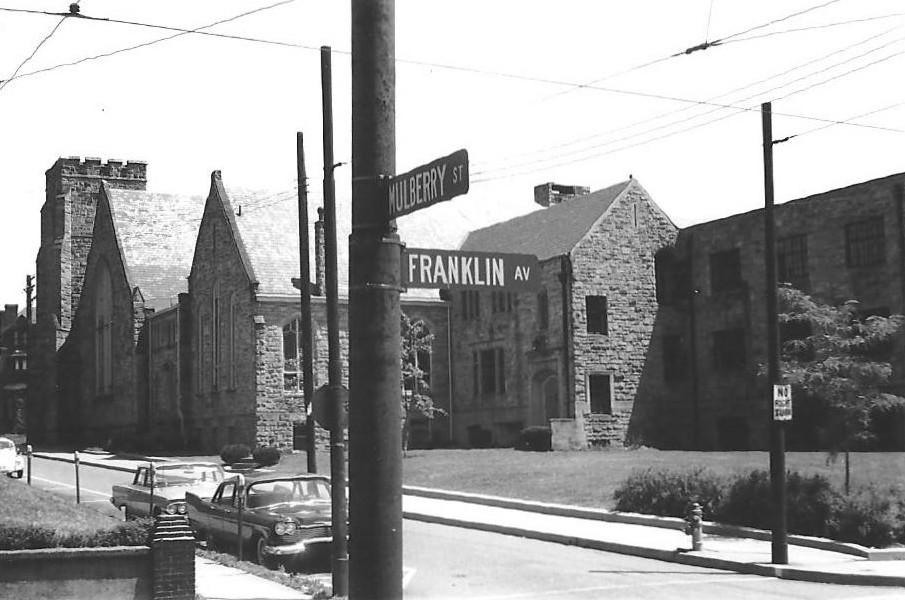
The Pittsburgh Press in 1972 announced a sermon at Mulberry by Rev. Richard G. Riedel called “If You Could Live Your Life All Over Again.”
The Second Presbyterian Church changed the name to Mulberry Presbyterian Church in May 1968.
The Northwood Presbyterian Church, formerly the First United Presbyterian Church of Wilkinsburg, merged with Mulberry Presbyterian Church in 1971.
The congregation in 1972 organized the Mulberry Senior Citizen Center. By 1999 it had a membership of 400 and met three days a week.
Virginia J. Adams taught and then served as principal at Johnston Elementary School for 35 years. At the Mulberry Presbyterian Church she worked in the Sunday school as a teacher and superintendent. After she retired from Johnston School, she volunteered at the Mulberry Senior Citizen Center for 25 years and often served on its board.
In 1988, “The Learning Tree,” a day care center and school, was in operation at Mulberry.
The Wilkinsburg Community Ministry over several decades operated from the ground floor of the Education Building. “We had, among other programs, tutoring, ESL, a food pantry, a soup kitchen, Angel Food, a clothing bank, a furniture and furnishings bank, Meals on Wheels, and a variety of social services. Neighbors could buy bus passes, get help with utility bills, help with insurance, completing tax forms, and general help with all kinds of problems. . . ”
In 1999, in addition the Wilkinsburg Community Ministry and the Senior Citizens Center, the Children’s Hospital Family Care Connection and the Allegheny Intermediate Unit were in the Education Building.
A 2006 Pittsburgh Post-Gazettearticle describes the Children’s Hospital Family Care Connection at Mulberry. “It provides care to about 200 children, giving them immunizations and helping pre-school youths get ready kindergarten, and helping parents with literacy and nutrition.”
A new congregation called the Mulberry Community Church with Rev. Kevin E. Cooper began meeting at Mulberry Presbyterian Church for a 9:30 a.m. Sunday service in 2000. A 2002 photo shows the service beginning at 9:15 with a sermon of “Changing Your Ways,” by Rev. Cooper and at 11:00 “The Blessings of God” by Rev. James Snyder of Mulberry Presbyterian.
The Historic Landmarks Plaque Committee of the Pittsburgh History and Landmarks Foundation awarded Mulberry Presbyterian Church with a historic designation plaque in 2002. “To be eligible, buildings, structures, districts or landscapes must be . . . ‘remarkable pieces of architecture, engineering, construction, landscape design or planning.’ or they musts impart ‘a rich sense of history.$rsquo; ”
The Wilkinsburg Update in 2003 covered Mulberry’ centennial celebration.
The centennial celebration took place on Sunday, October 19 when nearly 200 came to share memories through the years. Young families and children filled the pews where once their grandparents and great grandparents sat in worship. the sound of jubilant singing, trumpets & bagpipes cascaded from the choir loft. The Rev. Len Millison returned from Key West, Florida to preach with his wisdom and humor. A lovely dinner followed with a recounting of the church’s history and cherishing old images in photos and video. The church family looks forward to many more years of serving Wilkinsburg, yoking with other community churches to bring the love of Christ to our neighbors.
Rev. Leonard Earl Millison served for eight years as pastor at Mulberry before becoming the pastor at the Peace Covenant Church in Key West. He brought an international awareness to the Mulberry Church. He taught at Schutz American School for three years, a school founded by the United State Presbyterian Church in 1924 in Alexandria, Egypt, and later returned for 10 years as an administrator, teacher, and house parent. Over the decades he visited a wide variety of cultures and countries including Thailand, Turkey, India, Kenya, and Australia. In Florida, he worked for interfaith understanding, supported Habitat for Humanity, and belonged to the Southernmost Homeless Assistance League.
The Mulberry Community Church in 2004 purchased the former Grace United Evangelical Church at Wallace Avenue and Hay Street for the new location of the Mulberry Community Church.
The annual utility bill for a period of years at Mulberry Presbyterian approached $42,000. The Historic Religious Properties Committee of Pittsburgh History and Landmarks Foundation and the Saxer Foundation put together grant money in 2005 for an in-depth energy audit of Mulberry Church. The audit found ways to reduce the utility cost by a potential $9000 a year.
Attendance at church services averaged approximately 25 members in 2006. The declining membership and the high utility bills caused the Pittsburgh Presbytery to close the church on November 28. Several members of the Mulberry Church joined the Edgewood Presbyterian Church though a formal merger did not take place. The Mulberry Senior Center briefly moved to Edgewood Presbyterian before ending its program.
Pittsburgh Presbytery sold Mulberry to Strength Inc., a nonprofit social service and religious group involved with counseling and recovery, on December 27, 2006, for $700,000.
The Wilkinsburg Community Ministry, on short notice, moved to its present location at 704 Wood Street.
In 2010 the IRS delisted Strength Inc. as a nonprofit after the group did not file tax returns. Bills and taxes accumulated. A February 2013 Pittsburgh Post-Gazette article reported the former Mulberry Church as vacant.
The Center for Civic Arts became the conservator of Mulberry in 2019. They have networked with volunteers and community groups including the Wilkinsburg Historical Society to move forward toward a community center called the Mulberry Project that could offer a wide range of possibilities and help in revitalizing Wilkinsburg.
______
George Whitefield Mead, “Social and Spiritual,” The Expositor and Current Anecdotes, January 1907, p. 161–162.
“Guide to the Mulberry and Northwood Presbyterian Churches, Wilkinsburg, Pa. Records, 1882–1992 AIS.1992.10,” University of Pittsburgh, ULS Archives & Special Collections.
https://digital.library.pitt.edu/islandora/object/pitt%3AUS-PPiU-ais199210/viewer
“Virginia J. Adams,” Pittsburgh Tribune Review, December 23, 2005.
https://www.legacy.com/us/obituaries/triblive-pittsburgh-tribune-review/name/virginia-adams-obituary?pid=182167430
Marjorie Michaux, editor-in-chief, Historic Wilkinsburg 1887–1987, One Hundred Years of Pride. Wilkinsburg Centennial Publication Committee, 1988, p.
“Rev. Leonard Earl Millison,” Pittsburgh Post-Gazette, April 1, 2007.https://www.legacy.com/obituaries/postgazette/obituary.aspx?n=leonard-earl-millison&pid=87005719
“Was this church [Mulberry Presbyterian] important to you, your family, and/or the community?” The Well, Wilkinsburg Community Ministry, July 2021, p. 8.
Shaun Cloonan, “First Presbyterian Church of Edgewood, the Community Church, Quasquicentennial Anniversary, Celebrating 125 Years: Remembering the Last 25 (1991–2016). ”
http://www.fpcedgewood.org/uploads/2/3/8/3/23831749/the_last_25_years__1991-2016_.pdf
Ervin Dyer, “Sale of Wilkinsburg church a godsend to many agencies,” Pittsburgh Post-Gazette, December 27, 2006.
https://www.post-gazette.com/local/east/2006/12/27/Sale-of-Wilkinsburg-church-a-godsend-to-many-agencies/stories/200612270177
“Historic Religious Properties Receive Energy Audits” “PHLF News”, February 16, 2006.
Wilkinsburg Public Library Digital Archives:
Harry E. Carmack and Robert E. Carmack, compilers, “A History of the Second Presbyterian Church of Wilkinsburg” in Golden Anniversary: The Church History, Second Presbyterian Church, 1903–1953, pp. 1–26.
“We Welcome You, The Second Presbyterian Church of Wilkinsburg,” 1950s.
Frank Gardner, &Kevin [E.] Cooper Named Pastor at Mulberry Community Church,” Wilkinsburg Update, June 2000.
Pete Bishop, “11 area structures awarded historical status, Honored buildings receive plaques from landmarks foundation,” Tribune-Review, June 30, 2002, church sign photo by Sidney L. Davis.
Linda Knapp, “Mulberry Presbyterian Church Celebrates 100 Years of Ministry to the Wilkinsburg Community,” Wilkinsburg Update, November and December 2003.